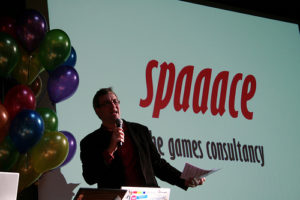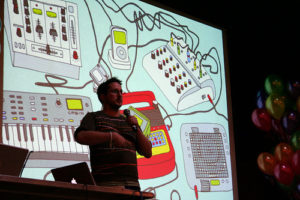



Pixel-labs’ “Playful:Game Design London” at Conway hall (30/10/08) was part of the London Games Festival Fringe. It wasn’t what I expected. I hadn’t done my homework before going and I had only seen a list of presenters next to the organisations that they represented. I expected corporate plugs of their latest products, the Beeb’s latest convergence project, some cutscene showreels etc. No, it was more than that. Whilst presenters proudly boasted their affiliations they also presented their own work. The event could arguably be described as Dorkbot for videogames. Dorkbot’s strapline ‘people doing strange things with electricity’; this time the electricity is powering Xboxes, PCs and Wii’s (oh and the other ones too!) A brief description of the presentations should give a decent idea of the richness of the event.
First up was James Wallis of Spaaace (to be enunciated in a 50’s Flash Gordon stylee!) commenting on the history of textual play from OuLiPo to Fighting Fantasy books and how heavy handed government intervention was responsible for the Electronic Frontier Foundation.

James Wallis
Next was Roo Reynolds of the BBC on how to turn a Rock Band guitar into a real musical instrument by using key mapping software, interfacing with Garage Band and pumping it all into a wah-wah pedal and a guitar amp. Hotel California was never one of my favourite tracks but a commendable performance was given. Rock!
Adrian Hon, Six To Start, wouldn’t talk about ARG’s – Adrian and His brother Dan worked on the award winning Perplex City – but instead discussed his drinking whilst playing Team Fortress 2 across time zones. It started whilst trying to get to sleep after being wired as well as playing on American servers late at night. This was ironic as his partner was working on an alcohol awareness campaign at the time.
Chris Delay, Introversion, explained procedural generation; how to make trees and cities from a simple set of rules or how to produce art without an art team.
Matthew Irvine Brown, Last.fm, makes interfaces; musical ones, familiar ones. Trumpet Hero anyone? Or even Sousaphone Hero. Get the notes wrong and a member of the brass band falls over drunk. Matthew also makes remote controlled cars, well, breath controlled and based around wind instrument breathing exercises plus musical sock puppets-play a scale whilst opening and closing the sock puppets mouth. The sock puppets were installed at club events where the punters then turned them into flirty social toys.
Eric Clough, 212Box, discussed the project “Mystery on Fifth Avenue”. His design firm were commissioned to redecorate a New York apartment. The twist is that the apartment was turned into a puzzle game. A secret panel somewhere in the house opens to reveal a book with clues leading to inscriptions hidden in murals. With the furniture transforming when secret keys are used to open panels revealing more clues. The game was designed for the children living in the apartment.
Jolyon Webb, Blitz Games Studios, was asked by organiser Toby Barnes to explain why teeth are so badly portrayed in videogames, so Jolyon explained a few things based around the tendency to model perfect Hollywood choppers. described how intensive it is to model realistic teeth and how they affect the entire facial expression. Jolyon currently works with medical modelling and is developing human busts that represent blood loss and trauma. He screened an extremely disturbing video of a simulated head slowly bleeding to death and also an interface to model and refine extremely realistic dynamic feature modelling. The kind of thing that many video games use to create an avatars features although much more realistic, however it is still very easy to model ‘hillbillies’-we’ve all done it!
Kars Christian Pieter, Alfrink, on playgrounds that kids build themselves, developing sandbox scenarios where play emerges…from skateboarding in disused swimming pools to describing games as ‘tools for having fun’.
Matt Biddulph, Dopplr, enthused about the Arduino board which allows hardware devices to interface with each other. Particularly interesting is the new DS Brut which is a cartridge for the Nintendo DS that allows all sorts of potential connectivity. He also showed Johnny Lee’s wiimote IR tracking experiments, does anybody remember the trackir? It isn’t open source but has been available to simulation nuts for quite some time.

Matt Biddulph
Alex Fleetwood, Sandpit and the Hide and Seek festival, talked about his new project but it’s meant to be a little hush hush at the mo’.
Iain Tait of Poke’s obsession with high scores had parallels with Tom Armitage of Headshift’s presentation on how we have always been multi-player. The discussions and stories told outside the actual game environment have always been critical, many a pub tale or bragging session has stemmed from play. the original high score table in classic arcade games to the narratives, stories and tales that games generate, designers build commonality and sociality into games.
Eric Zimmerman, Gamelab, discussed games as a form of literacy and presented his latest on-line game creation system.
Kieron Gillen, writer, discussed how important plagiarism is! Lemme explain… most games are an evolution of what has been previously successful, however many game elements and mechanics from the past should be revisited. “Little Computer People” in the late 80’s to “The Sims” is a very successful example of this. The only problem is that developers stick to what is commercially viable and are reluctant to try some of the more off the wall ideas.
It was a fun and entertaining day that presented a significant amount of hacking, fiddling, noodling and pootling around the notion of play and games from social interactions to novel interfaces. But the format precluded any discussion at the actual event with no formal discussion panel staged. There was lots of chatting in the pub post-event though. It’s also interesting to note that little was mentioned relating the practice to art although design, production, agency and sociality were covered. There was little explicit mention of art apart from Alex Fleetwood who specifically placed his practice as art. This is significant considering the parallels with the more playful aspects of media arts and may be symptomatic of the ‘design’ oriented title of the event, although as media artists, if we are still allowed to use that term, there’s a lot of commonality in both practice and discourse.